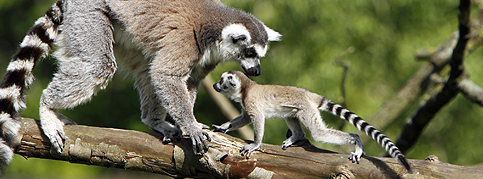Ring-tailed lemurs.
The cute little fellows with the hooped tail
Like the black-and-white ruffed lemurs, ring-tailed lemurs are part of the primate family of lemurs, which is native to the island of Madagascar. Unlike other lemur species, ring-tailed lemurs spend a lot of time on the ground and are mainly active during the day. At night they retire to the trees or caves to sleep and in the morning they like to expose their bellies to the warm sun.
Characteristics
Ring-tailed lemurs are around 40 to 45 centimetres in size and have an unmistakeable hooped tail of around 60 centimetres in length. They weigh between 2.2 and 3.5 kilograms. Males and females are about the same size. Their back is grey-brown in colour, the belly is white and their arms and legs light grey. With their leathery balls of the hand and feet, ring-tailed lemurs are also expert climbers in rough, rocky terrain.
Area of origin
Ring-tailed lemurs originally come from the island of Madagascar, where they are at home in the south and south west. Whilst other lemur species spend most of the time in the forests, ring-tailed lemurs can also be found in unforested, rocky mountain terrain and dry savannahs.
Diet
Ring-tailed lemurs love fruit, but also eat leaves, buds and tree bark. Alongside spiders and insects they also eat small birds and chameleons. One of their main food sources is the tamarind tree. In dry regions they meet their fluid requirements by eating succulents (water-storing plants such as cacti) like aloes.
Conservation status
Through the destruction of forests for charcoal production or the transformation of forests to pasture for cattle, the established habitat of the ring-tailed lemurs is getting ever smaller. Additionally, the small primates are hunted in some areas and have natural predators such as domestic cats, snakes or birds of prey. Nonetheless, stocks of ring-tailed lemurs are less endangered than other lemur species due to their flexibility.
Wonderful Madagascar!











